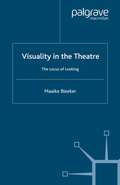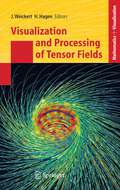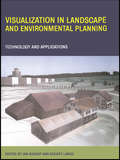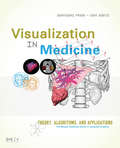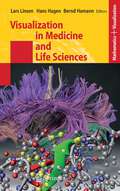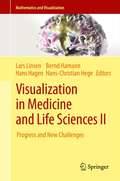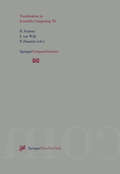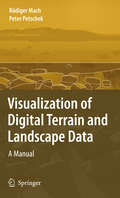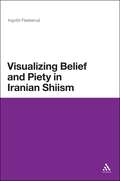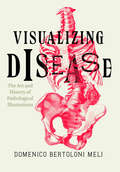- Table View
- List View
Visuality in the Theatre: The Locus of Looking (Performance Interventions)
by M. BleekerThis book presents an exploration of the under-explored terrain of visuality, demonstrating the use of new theoretical insights into vision for the analysis of theatre and performance and simultaneously shows theatre and performance to be an excellent 'theoretical object' for exploring the cultural, historical and embodied character of visuality.
Visualization Analysis and Design
by Tamara MunznerLearn How to Design Effective Visualization SystemsVisualization Analysis and Design provides a systematic, comprehensive framework for thinking about visualization in terms of principles and design choices. The book features a unified approach encompassing information visualization techniques for abstract data, scientific visualization techniques
Visualization Analysis and Design (Ak Peters Visualization Ser.)
by Tamara MunznerLearn How to Design Effective Visualization SystemsVisualization Analysis and Design provides a systematic, comprehensive framework for thinking about visualization in terms of principles and design choices. The book features a unified approach encompassing information visualization techniques for abstract data, scientific visualization techniques
Visualization and Mathematics: Experiments, Simulations and Environments
by H. C Hege K. PolthierVisualization and mathematics have begun a fruitful relationship, establishing links between problems and solutions of both fields. In some areas of mathematics, like differential geometry and numerical mathematics, visualization techniques are applied with great success. However, visualization methods are relying heavily on mathematical concepts.Applications of visualization in mathematical research and the use of mathematical methods in visualization have been topic of an international workshop in Berlin in June 1995. Selected contributions treat topics of particular interest in current research. Experts are reporting on their latest work, giving an overview on this fascinating new area. The reader will get insight to state-of-the-art techniques for solving visualization problems and mathematical questions.
Visualization and Processing of Higher Order Descriptors for Multi-Valued Data (Mathematics and Visualization)
by Ingrid Hotz Thomas SchultzModern imaging techniques and computational simulations yield complex multi-valued data that require higher-order mathematical descriptors. This book addresses topics of importance when dealing with such data, including frameworks for image processing, visualization and statistical analysis of higher-order descriptors. It also provides examples of the successful use of higher-order descriptors in specific applications and a glimpse of the next generation of diffusion MRI. To do so, it combines contributions on new developments, current challenges in this area and state-of-the-art surveys.Compared to the increasing importance of higher-order descriptors in a range of applications, tools for analysis and processing are still relatively hard to come by. Even though application areas such as medical imaging, fluid dynamics and structural mechanics are very different in nature they face many shared challenges. This book provides an interdisciplinary perspective on this topic with contributions from key researchers in disciplines ranging from visualization and image processing to applications. It is based on the 5th Dagstuhl seminar on Visualization and Processing of Higher Order Descriptors for Multi-Valued Data.This book will appeal to scientists who are working to develop new analysis methods in the areas of image processing and visualization, as well as those who work with applications that generate higher-order data or could benefit from higher-order models and are searching for novel analytical tools.
Visualization and Processing of Tensor Fields: Advances and Perspectives (Mathematics and Visualization)
by David H. Laidlaw Joachim WeickertVisualization and Processing of Tensor Fields (Mathematics and Visualization)
by Joachim Weickert Hans HagenMatrix-valued data sets – so-called second order tensor fields – have gained significant importance in scientific visualization and image processing due to recent developments such as diffusion tensor imaging. This book is the first edited volume that presents the state of the art in the visualization and processing of tensor fields. It contains some longer chapters dedicated to surveys and tutorials of specific topics, as well as a great deal of original work by leading experts that has not been published before. It serves as an overview for the inquiring scientist, as a basic foundation for developers and practitioners, and as as a textbook for specialized classes and seminars for graduate and doctoral students.
Visualization and Processing of Tensors and Higher Order Descriptors for Multi-Valued Data (Mathematics and Visualization)
by Carl-Fredrik Westin Anna Vilanova Bernhard BurgethArising from the fourth Dagstuhl conference entitled Visualization and Processing of Tensors and Higher Order Descriptors for Multi-Valued Data (2011), this book offers a broad and vivid view of current work in this emerging field. Topics covered range from applications of the analysis of tensor fields to research on their mathematical and analytical properties.Part I, Tensor Data Visualization, surveys techniques for visualization of tensors and tensor fields in engineering, discusses the current state of the art and challenges, and examines tensor invariants and glyph design, including an overview of common glyphs.The second Part, Representation and Processing of Higher-order Descriptors, describes a matrix representation of local phase, outlines mathematical morphological operations techniques, extended for use in vector images, and generalizes erosion to the space of diffusion weighted MRI.Part III, Higher Order Tensors and Riemannian-Finsler Geometry, offers powerful mathematical language to model and analyze large and complex diffusion data such as High Angular Resolution Diffusion Imaging (HARDI) and Diffusion Kurtosis Imaging (DKI).A Part entitled Tensor Signal Processing presents new methods for processing tensor-valued data, including a novel perspective on performing voxel-wise morphometry of diffusion tensor data using kernel-based approach, explores the free-water diffusion model, and reviews proposed approaches for computing fabric tensors, emphasizing trabecular bone research.The last Part, Applications of Tensor Processing, discusses metric and curvature tensors, two of the most studied tensors in geometry processing. Also covered is a technique for diagnostic prediction of first-episode schizophrenia patients based on brain diffusion MRI data. The last chapter presents an interactive system integrating the visual analysis of diffusion MRI tractography with data from electroencephalography.
Visualization in Landscape and Environmental Planning: Technology and Applications
by Ian D. Bishop Eckart LangeThis major reference presents the challenges, issues and directions of computer-based visualization of the natural and built environment and the role of such visualization in landscape and environmental planning. It offers a uniquely systematic approach to the potential of visualization and the writers are acknowledged experts in their field of specialization. Case studies are presented to illustrate many aspects of landscape management including forestry, agriculture, ecology, mining and urban development.
Visualization in Landscape and Environmental Planning: Technology and Applications
by Ian Bishop Eckart LangeThis major reference presents the challenges, issues and directions of computer-based visualization of the natural and built environment and the role of such visualization in landscape and environmental planning. It offers a uniquely systematic approach to the potential of visualization and the writers are acknowledged experts in their field of specialization. Case studies are presented to illustrate many aspects of landscape management including forestry, agriculture, ecology, mining and urban development.
Visualization in Medicine: Theory, Algorithms, and Applications (The Morgan Kaufmann Series in Computer Graphics)
by Bernhard Preim Dirk BartzVisualization in Medicine is the first book on visualization and its application to problems in medical diagnosis, education, and treatment. The book describes the algorithms, the applications and their validation (how reliable are the results?), and the clinical evaluation of the applications (are the techniques useful?). It discusses visualization techniques from research literature as well as the compromises required to solve practical clinical problems. The book covers image acquisition, image analysis, and interaction techniques designed to explore and analyze the data. The final chapter shows how visualization is used for planning liver surgery, one of the most demanding surgical disciplines. The book is based on several years of the authors' teaching and research experience. Both authors have initiated and lead a variety of interdisciplinary projects involving computer scientists and medical doctors, primarily radiologists and surgeons.* A core field of visualization and graphics missing a dedicated book until now* Written by pioneers in the field and illustrated in full color* Covers theory as well as practice
Visualization in Medicine and Life Sciences (Mathematics and Visualization)
by Lars Linsen Hans Hagen Bernd HamannVisualization technology is becoming increasingly important for medical and biomedical data processing and analysis. The interaction between visualization and medicine is one of the fastest expanding fields, both scientifically and commercially. This book discusses some of the latest visualization techniques and systems for effective analysis of such diverse, large, complex, and multi-source data.
Visualization in Medicine and Life Sciences II: Progress and New Challenges (Mathematics and Visualization)
by Lars Linsen Hans Hagen Bernd Hamann Hans-Christian HegeFor some time, medicine has been an important driver for the development of data processing and visualization techniques. Improved technology offers the capacity to generate larger and more complex data sets related to imaging and simulation. This, in turn, creates the need for more effective visualization tools for medical practitioners to interpret and utilize data in meaningful ways. The first edition of Visualization in Medicine and Life Sciences (VMLS) emerged from a workshop convened to explore the significant data visualization challenges created by emerging technologies in the life sciences. The workshop and the book addressed questions of whether medical data visualization approaches can be devised or improved to meet these challenges, with the promise of ultimately being adopted by medical experts. Visualization in Medicine and Life Sciences II follows the second international VMLS workshop, held in Bremerhaven, Germany, in July 2009. Internationally renowned experts from the visualization and driving application areas came together for this second workshop. The book presents peer-reviewed research and survey papers which document and discuss the progress made, explore new approaches to data visualization, and assess new challenges and research directions.
Visualization in Medicine and Life Sciences III: Towards Making an Impact (Mathematics and Visualization)
by Lars Linsen Bernd Hamann Hans-Christian HegeThe book discusses novel visualization techniques driven by the needs in medicine and life sciences as well as new application areas and challenges for visualization within these fields. It presents ideas and concepts for visual analysis of data from scientific studies of living organs or to the delivery of healthcare. Target scientific domains include the entire field of biology at all scales - from genes and proteins to organs and populations - as well as interdisciplinary research based on technological advances such as bioinformatics, biomedicine, biochemistry, or biophysics. Moreover, they comprise the field of medicine and the application of science and technology to healthcare problems. This book does not only present basic research pushing the state of the art in the field of visualization, but it also documents the impact in the fields of medicine and life sciences.
Visualization in Scientific Computing (Focus on Computer Graphics)
by Michel Grave Yvon Le Lous W. Terry HewittVisualization in scientific computing is getting more and more attention from many people. Especially in relation with the fast increase of com puting power, graphic tools are required in many cases for interpreting and presenting the results of various simulations, or for analyzing physical phenomena. The Eurographics Working Group on Visualization in Scientific Com puting has therefore organized a first workshop at Electricite de France (Clamart) in cooperation with ONERA (Chatillon). A wide range of pa pers were selected in order to cover most of the topics of interest for the members of the group, for this first edition, and 26 of them were presented in two days. Subsequently 18 papers were selected for this volume. 1'he presentations were organized in eight small sessions, in addition to discussions in small subgroups. The first two sessions were dedicated to the specific needs for visualization in computational sciences: the need for graphics support in large computing centres and high performance net works, needs of research and education in universities and academic cen tres, and the need for effective and efficient ways of integrating numerical computations or experimental data and graphics. Three of those papers are in Part I of this book. The third session discussed the importance and difficulties of using stan dards in visualization software, and was related to the fourth session where some reference models and distributed graphics systems were discussed. Part II has five papers from these sessions.
Visualization in Scientific Computing ’95: Proceedings of the Eurographics Workshop in Chia, Italy, May 3–5, 1995 (Eurographics)
by Riccardo Scateni Jarke J. Van Wijk Pietro ZanariniVisualization is nowadays indispensable to get insight into the huge amounts of data pro duced by large scale simulations or advanced measurement devices. The use of com puter graphics for scientific purposes has become a well established discipline, known as Scientific Visualization. Many problems still have to be solved, and hence the field is a very active area for research and development. This book represents results of the sixth in a well established series of international workshops on Visualization in Scien tific Computing organized by the EUROGRAPHICS Association in collaboration with CRS4 (Center for Advanced Studies, Research and Development in Sardinia), held from May 3 to May 5,1995, in Chia, Italy. The thirteen contributions selected for this volume cover a wide range of topics, ranging from detailed algorithmic studies to searches for new metaphors. A rough di vision can be made into the parts interaction, irregular meshes, volume rendering, and applications. Interaction in three dimensions is a challenging area for research. The use of three dimensional user interfaces for more natural manipulation of three-dimensional data and their visualization is natural, but is far from trivial to realize. Pang et al. investigate the use of common objects such as spray cans and carving knives as metaphors for visualiza tion tools, in order to provide an intuitive and natural three dimensional user interface. Gibson uses a voxel-based data representation, not only for visualization, but also for physical modeling of objects. A prototype system under development for haptic explo ration is discussed.
Visualization in Scientific Computing ’97: Proceedings of the Eurographics Workshop in Boulogne-sur-Mer France, April 28–30, 1997 (Eurographics)
by Wilfrid Lefer Michel GraveVisualization is now recognized as a powerful approach to get insight in large datasets produced by scientific experimentations and simulations. The contributions to this book cover technical aspects as well as concrete applications of visualization in various domains such as finance, physics, astronomy and medicine, providing researchers and engineers with valuable information for setting up new powerful environments.
Visualization in Scientific Computing ’98: Proceedings of the Eurographics Workshop in Blaubeuren, Germany April 20–22, 1998 (Eurographics)
by Dirk Bartz9
Visualization of Digital Terrain and Landscape Data: A Manual
by Rüdiger Mach Peter PetschekThis book approaches the realisation of digital terrain and landscape data through clear and practical examples. From data provision and the creation of revealing analyses to realistic depictions for presentation purposes, the reader is led through the world of digital 3-D graphics. The authors’ deep knowledge of the scientific fundamentals and many years of experience in 3-D visualization enable them to lead the reader through a complex subject and shed light on previously murky virtual landscapes.
Visualization of Time-Oriented Data (Human–Computer Interaction Series)
by Wolfgang Aigner Silvia Miksch Heidrun Schumann Christian TominskiTime is an exceptional dimension that is common to many application domains such as medicine, engineering, business, or science. Due to the distinct characteristics of time, appropriate visual and analytical methods are required to explore and analyze them. This book starts with an introduction to visualization and historical examples of visual representations. At its core, the book presents and discusses a systematic view of the visualization of time-oriented data along three key questions: what is being visualized (data), why something is visualized (user tasks), and how it is presented (visual representation). To support visual exploration, interaction techniques and analytical methods are required that are discussed in separate chapters. A large part of this book is devoted to a structured survey of 101 different visualization techniques as a reference for scientists conducting related research as well as for practitioners seeking information on how their time-oriented data can best be visualized.
Visualizations of Urban Space: Digital Age, Aesthetics, and Politics (Advances in Urban Sustainability)
by Christiane WagnerThis book explores environments where art, imagination, and creative practice meet urban spaces at the point where they connect to the digital world. It investigates relationships between urban visualizations, aesthetics, and politics in the context of new technologies, and social and urban challenges toward the Sustainable Development Goals. Responding to questions stemming from critical theory, the book focuses on an interdisciplinary actualization of technological developments and social challenges. It demonstrates how art, architecture, and design can transform culture, society, and nature through artistic and cultural achievements, integration, and new developments. The book begins with the theoretical framework of social aesthetics theories before discussing global contemporary visual culture and technological evolution. Across the 12 chapters, it looks at how architecture and design play significant roles in causing and solving complex environmental transformations in the digital turn. By fostering transdisciplinary encounters between architecture, design, visual arts, and cinematography, this book presents different theoretical approaches to how the arts’ interplay with the environment responds to the logic of the constructions of reality. This book will appeal to scholars, researchers, and upper-level students in aesthetics, philosophy, visual cultural studies, communication studies, and media studies with a particular interest in sociopolitical and environmental discussions.
Visualizations of Urban Space: Digital Age, Aesthetics, and Politics (Advances in Urban Sustainability)
by Christiane WagnerThis book explores environments where art, imagination, and creative practice meet urban spaces at the point where they connect to the digital world. It investigates relationships between urban visualizations, aesthetics, and politics in the context of new technologies, and social and urban challenges toward the Sustainable Development Goals. Responding to questions stemming from critical theory, the book focuses on an interdisciplinary actualization of technological developments and social challenges. It demonstrates how art, architecture, and design can transform culture, society, and nature through artistic and cultural achievements, integration, and new developments. The book begins with the theoretical framework of social aesthetics theories before discussing global contemporary visual culture and technological evolution. Across the 12 chapters, it looks at how architecture and design play significant roles in causing and solving complex environmental transformations in the digital turn. By fostering transdisciplinary encounters between architecture, design, visual arts, and cinematography, this book presents different theoretical approaches to how the arts’ interplay with the environment responds to the logic of the constructions of reality. This book will appeal to scholars, researchers, and upper-level students in aesthetics, philosophy, visual cultural studies, communication studies, and media studies with a particular interest in sociopolitical and environmental discussions.
Visualizing and Exhibiting Jewish Space and History (Studies in Contemporary Jewry)
by Richard I. CohenContinuing its distinguished tradition of focusing on central political, sociological, and cultural issues of Jewish life in the last century, Volume XXVI of the annual Studies in Contemporary Jewry examines the visual revolution that has overtaken Jewish cultural life in the twentieth century onwards, with special attention given to the evolution of Jewish museums. Bringing together leading curators and scholars, Visualizing and Exhibiting Jewish Space and History treats various forms of Jewish representation in museums in Europe and the United States before the Second World War and inquires into the nature and proliferation of Jewish museums following the Holocaust and the fall of Communism in Western and Eastern Europe. In addition, a pair of essays dedicated to six exhibitions that took place in Israel in 2008 to mark six decades of Israeli art raises significant issues on the relationship between art and gender, and art and politics. An introductory essay highlights the dramatic transformation in the appreciation of the visual in Jewish culture. The scope of the symposium offers one of the first scholarly attempts to treat this theme in several countries. Also featured in this volume are a provocative essay on the nature of antisemitism in twentieth-century English society; review essays on Jewish fundamentalism and recent works on the subject of the Holocaust in occupied Soviet territories; and reviews of new titles in Jewish Studies..
Visualizing Belief and Piety in Iranian Shiism
by Ingvild FlaskerudThe representation of prophets and saints in Islam is erroneously considered nonexistent by many scholars of Islam, Muslims, and the general public. The issue is often dealt with superficially without attention to its deep roots in piety and religiosity. Visualizing Belief and Piety in Iranian Shiism offers new understanding of Islamic iconography and Muslim perspectives on the use of imageries in ritual contexts and devotional life. Combining iconographic and ethnographic approaches, Ingvild Flaskerud introduces and analyzes imageries (tile-paintings, posters and wall-hangings), ritual contexts and interviews with male and female local viewers to discuss the representation, reception and function of imageries in contemporary Iranian Shia environments. This book presents the argument that images and decorative programmes have stimulating qualities to mentally evoke the saints in the minds of devotees and inspire their recollection, transforming emotions and stimulating cultic behaviours. Visualization and seeing are significant to the dissemination of religious knowledge, the understanding of spiritual and ethical values, the promotion of personal piety, and functions as modes of venerating God and the saints.
Visualizing Disease: The Art and History of Pathological Illustrations
by Domenico Bertoloni MeliVisual anatomy books have been a staple of medical practice and study since the mid-sixteenth century. But the visual representation of diseased states followed a very different pattern from anatomy, one we are only now beginning to investigate and understand. With Visualizing Disease, Domenico Bertoloni Meli explores key questions in this domain, opening a new field of inquiry based on the analysis of a rich body of arresting and intellectually challenging images reproduced here both in black and white and in color. Starting in the Renaissance, Bertoloni Meli delves into the wide range of figures involved in the early study and representation of disease, including not just men of medicine, like anatomists, physicians, surgeons, and pathologists, but also draftsmen and engravers. Pathological preparations proved difficult to preserve and represent, and as Bertoloni Meli takes us through a number of different cases from the Renaissance to the mid-nineteenth century, we gain a new understanding of how knowledge of disease, interactions among medical men and artists, and changes in the technologies of preservation and representation of specimens interacted to slowly bring illustration into the medical world.
